Brand guides
Authenticating Puma kits
This guide breaks down the essential elements of an authentic Puma kit, from material choices to design precision. You'll also learn how to spot common red flags in fake shirts and get practical advice for verifying authenticity, whether you're browsing in a shop or buying secondhand online.
The product code label
One of the most reliable ways to begin authenticating a Puma kit is by checking the product code, usually found on a big label typically sewn into the left side of the shirt. It's referred to as either the Style No or Article No. The labeling system was introduced around the year 2000, so kits produced before that period may not feature a product code label at all, which is important to consider when assessing vintage items.
Early label versions
Although this label has remained largely consistent since its introduction, earlier versions may appear slightly different in format. They still contain the same essential information, but the layout or styling might vary. Keep in mind that this alone is not a sign the kit is fake, it's just part of the evolution of Puma labeling.

The product code
Puma product codes are a good starting point when verifying the authenticity of a football kit. The product codes found on the label are typically six-character numeric strings (e.g. 736251) augmented with an additional two-character numeric string (e.g. 01) indicating the variation. The two-letter code indicating the variation is something that can be seen on swing tags of earlier Puma kits, but it was not consistently present on the product code label until the 2018/19 season. Given that a lot of the second-hand market kits do not come with swing tags, we've opted for only including it in our dataset on kits from 2018 onwards.
While these codes can help confirm that a kit's design exists and matches what it claims to be, they aren't foolproof. For that reason, Puma product codes are best used in combination with other indicators like stitching quality, print accuracy, and label details.
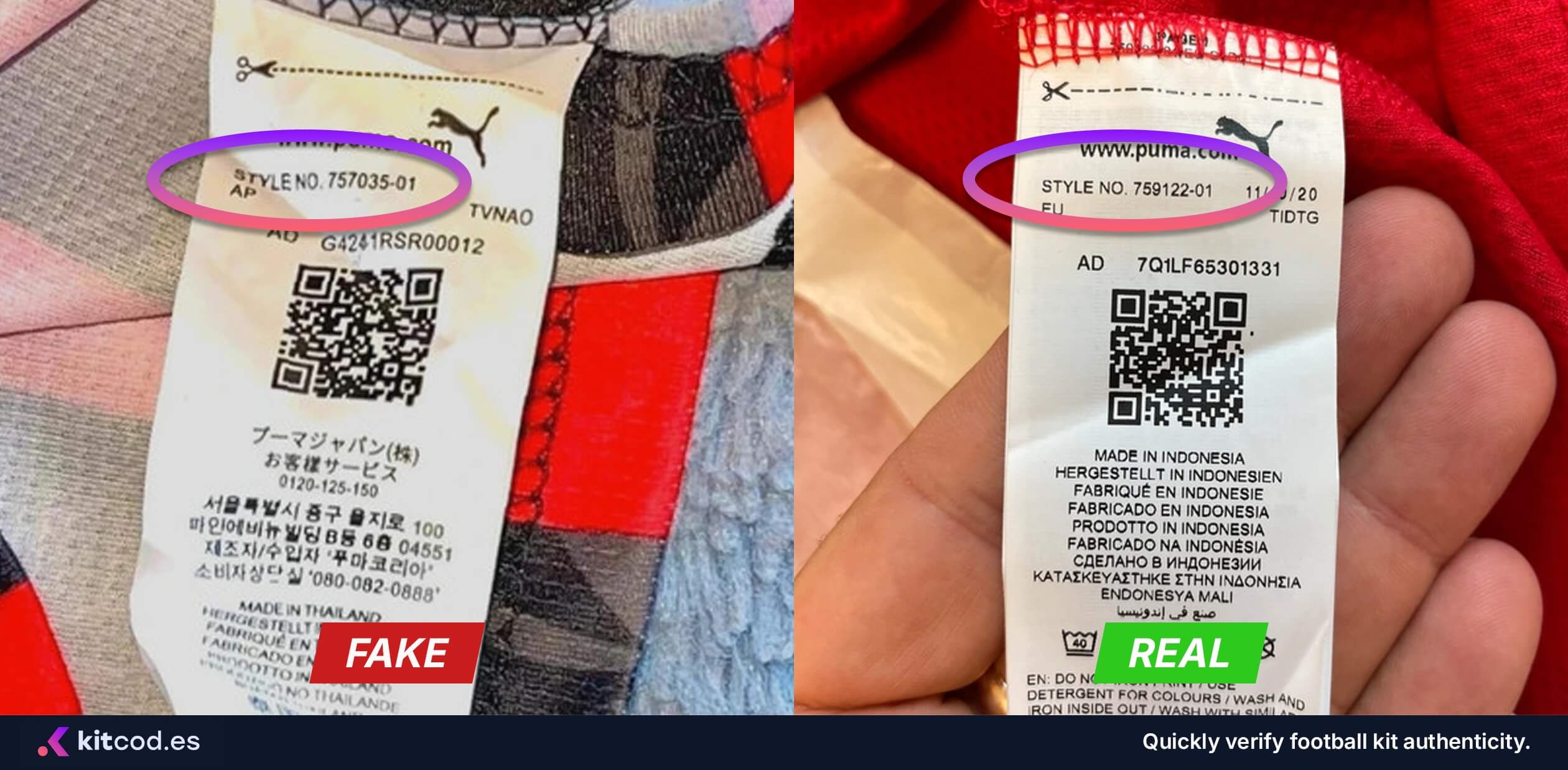
Using the shirts above, we can verify the product codes using kitcod.es. The fake shirt returns a result for an Olympique Marseille kit, while the shirt being sold is presented as an AC Milan kit, a clear mismatch. In contrast, the real kit yields a correct match for the AC Milan home shirt.
Right code, wrong kit
Counterfeit kits often reuse real product codes to appear more convincing. That code is valid, but only for that specific kit. If you see the same code on a different team's kit, it's almost certainly fake. A matching code doesn't always guarantee authenticity, but a mismatched one is a strong red flag.
The production date
The product code label found inside Puma kits does more than just display the product code, it also provides helpful information about when the shirt was produced. Puma has started to include the actual production date on recent versions of this label. This is especially helpful when checking whether a shirt's production date aligns with its claimed season. Counterfeit shirts often reuse the same label across different kits, which can result in inconsistencies or illogical combinations.
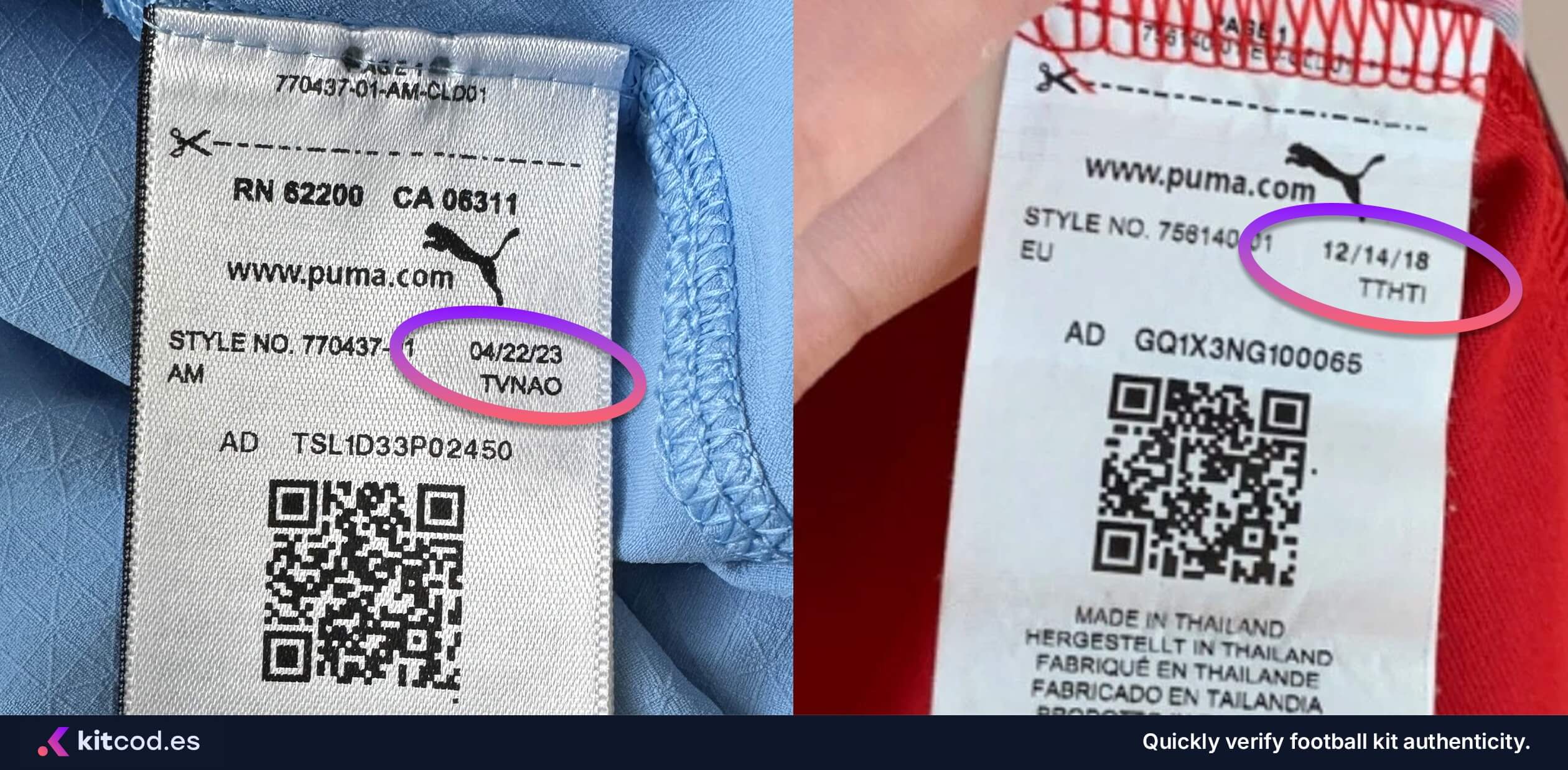
The production region
In addition to the visible "Made in..." text indicating the country of manufacture, Puma product labels often include a smaller alphanumeric code just beneath the production date. This code provides further insight, not only into what country the item was produced, but potentially even the specific factory.
While the exact structure of these codes is not publicly documented, we can reasonably interpret them based on patterns seen across multiple products. Let's take the code TVNAO as an example:
| Code | Meaning |
|---|---|
| T | Likely a prefix, possibly stands for Textile |
| VN | ISO country code, in this case, Vietnam |
| AO | Factory identifier, likely Alliance One Apparel Company Ltd |
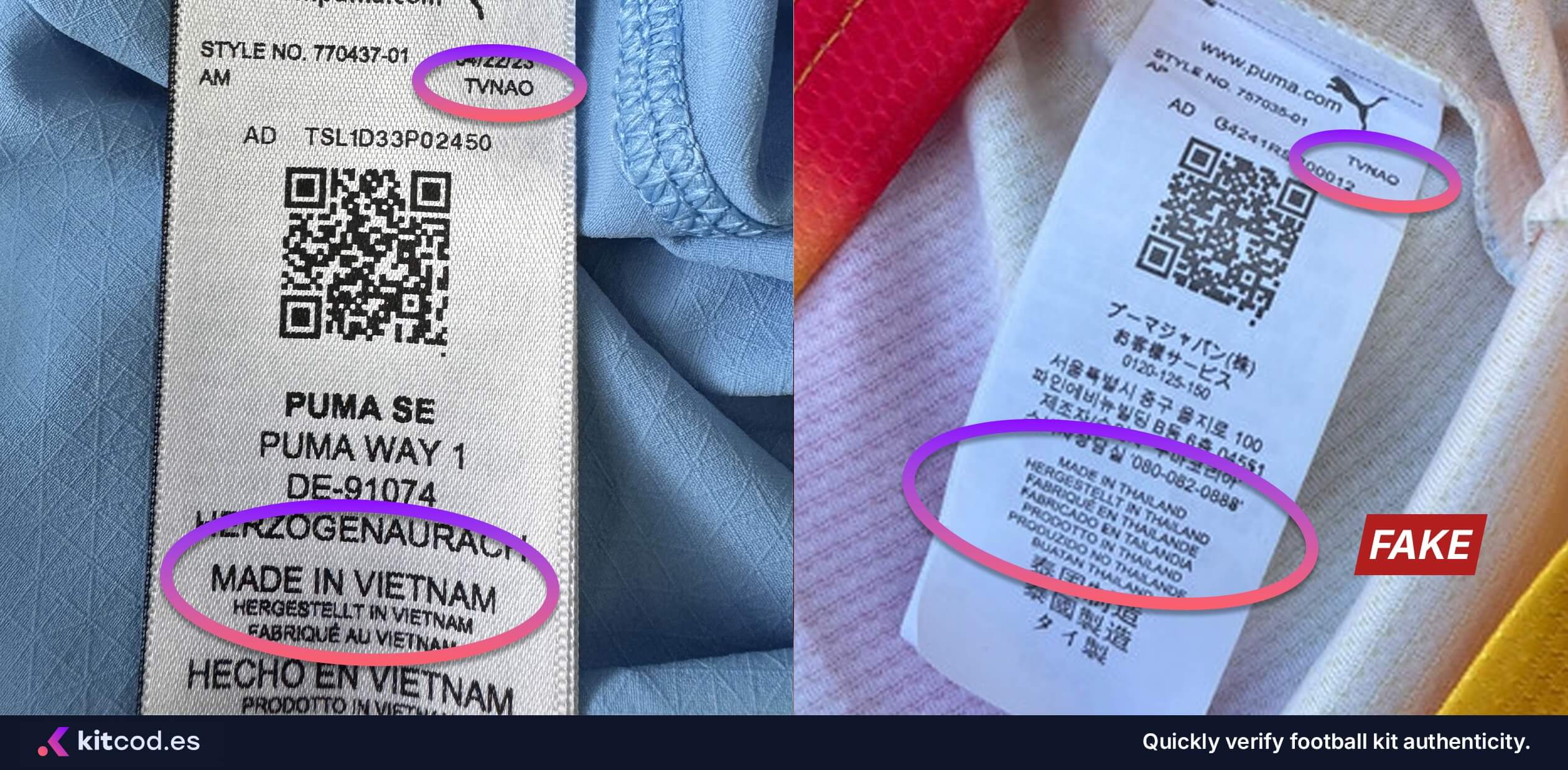
As a general rule, the country code (e.g., VN) should match the country listed in the "Made in..." section of the label. The factory code is more difficult to decipher without context, but Puma periodically publishes factory lists which can help narrow things down. You can consult lists from 2018, 2023 or 2025 to identify potential matches by country and name.
For instance, if your product says "Made in Vietnam" and the code ends in AO, cross-referencing the 2023 Puma factory list reveals a match: Alliance One Apparel Co., Ltd., a known supplier located in Ben Tre Province, Vietnam.
Market regions
In addition to the factory and production information, Puma product labels also include a regional market identifier. This code is typically found on the left-hand side of the label, just below the product code. It does not indicate where the item was manufactured, but rather the intended target market for resale.
Here are some common examples:
| Code | Meaning |
|---|---|
| AM | Americas |
| AP | Asia Pacific |
| EU | Europe |
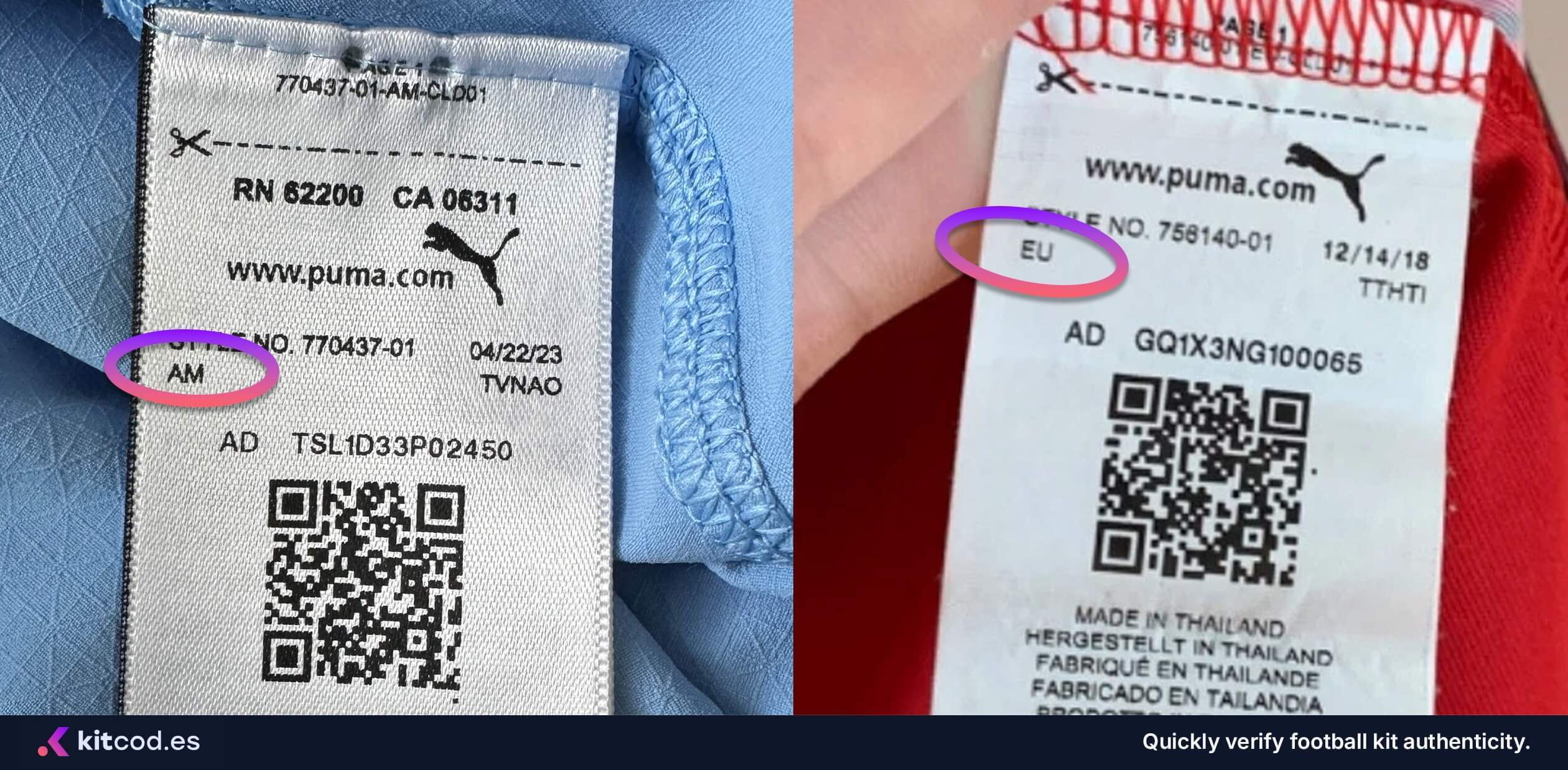
These codes can be helpful for collectors or resellers looking to identify region-specific releases or distribution patterns. While the product itself may be identical across markets, slight variations in labeling, packaging, or compliance information may differ based on the designated region.
The QR-code
Newer Puma product tags often feature a QR code, typically located beneath the product code. Scanning this code usually redirects to the Puma website, with the unique “AD” number (printed above the QR code) appended as a query string. This code may serve internal tracking, inventory, or authentication purposes.
Here are a couple of examples for QR codes found elsewhere in this article:
https://www.puma.com?TSL1D33P02450https://www.puma.com?GQ1X3NG100065
Template kits
When you see a strange variation of product codes on a Puma kit, it might mean that the shirt is a custom design based on a standard template. This setup is common for smaller clubs, limited editions, or one-off runs.

Sample kits
Sample kits are pre-production versions of Puma apparel, typically created for internal use, promotional previews, or to showcase upcoming designs to clubs, retailers, or sponsors. These kits often feature unique tags, such as labels marked "SAMPLE – NOT FOR RESALE" or slightly different internal codes not found on retail versions.
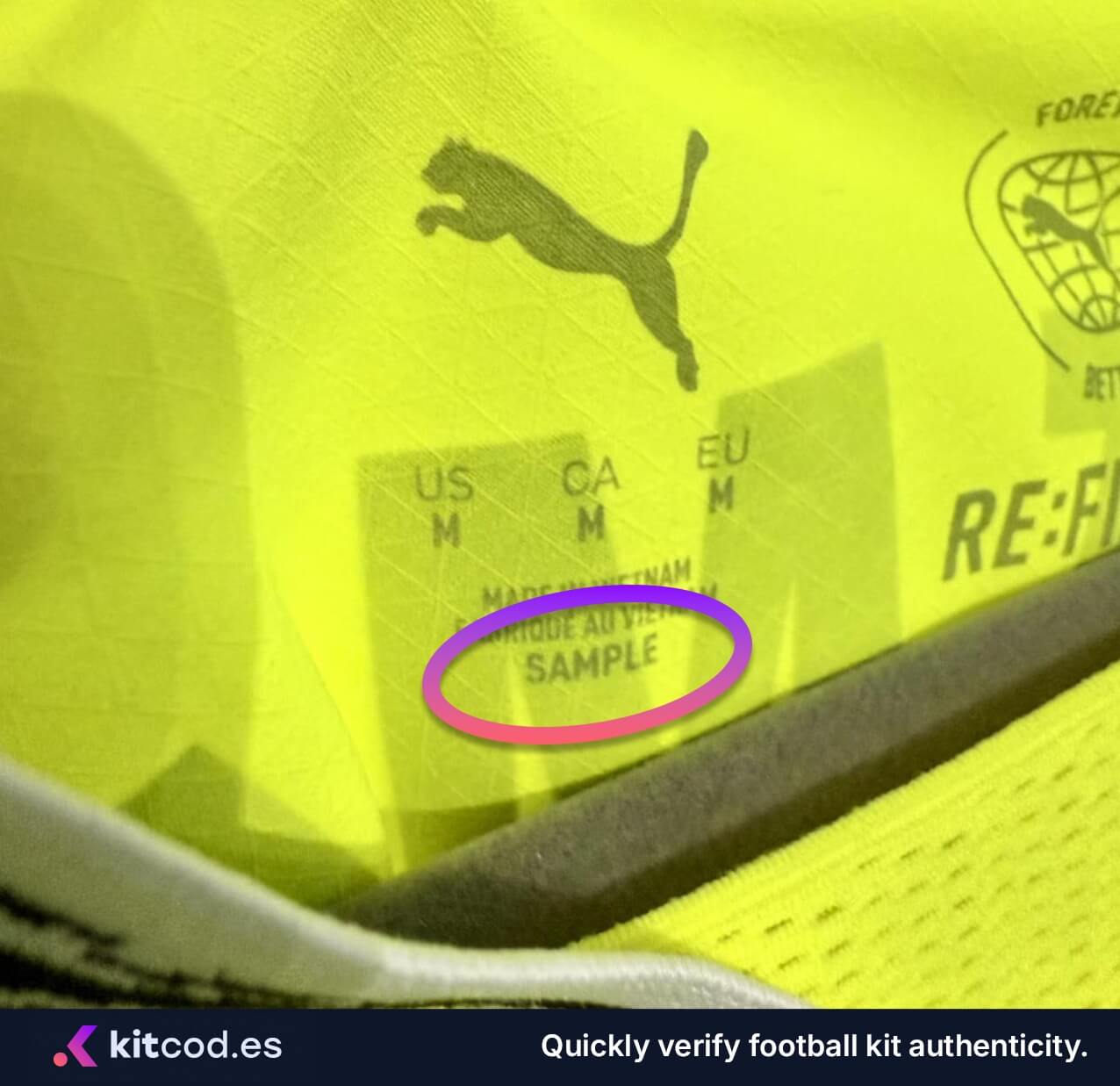
While the overall design is usually identical or very close to the final product, minor differences may exist in stitching, fabric, sizing, or detailing. Sample kits can sometimes surface on secondary markets, making them sought-after by collectors due to their rarity and behind-the-scenes origin.
However, since they aren't always subject to the same quality control as retail versions, it's important to examine them carefully, especially when verifying authenticity.
The swing tags
A swing tag is the detachable cardboard tag typically attached to a new kit, usually hanging from the neck area by a plastic barb. It contains key product information like the size, barcode, product code, and pricing. In the world of football kits, swing tags are important for collectors, as they can help verify authenticity and confirm the kit is unworn or in original retail condition.
Design
Puma swing tags come in lots of variations. However, these tags typically include a removable sticker that displays key information such as the product code and sizing. One important detail to watch for is that authentic tags typically use a real, physical sticker instead of a printed-on label.
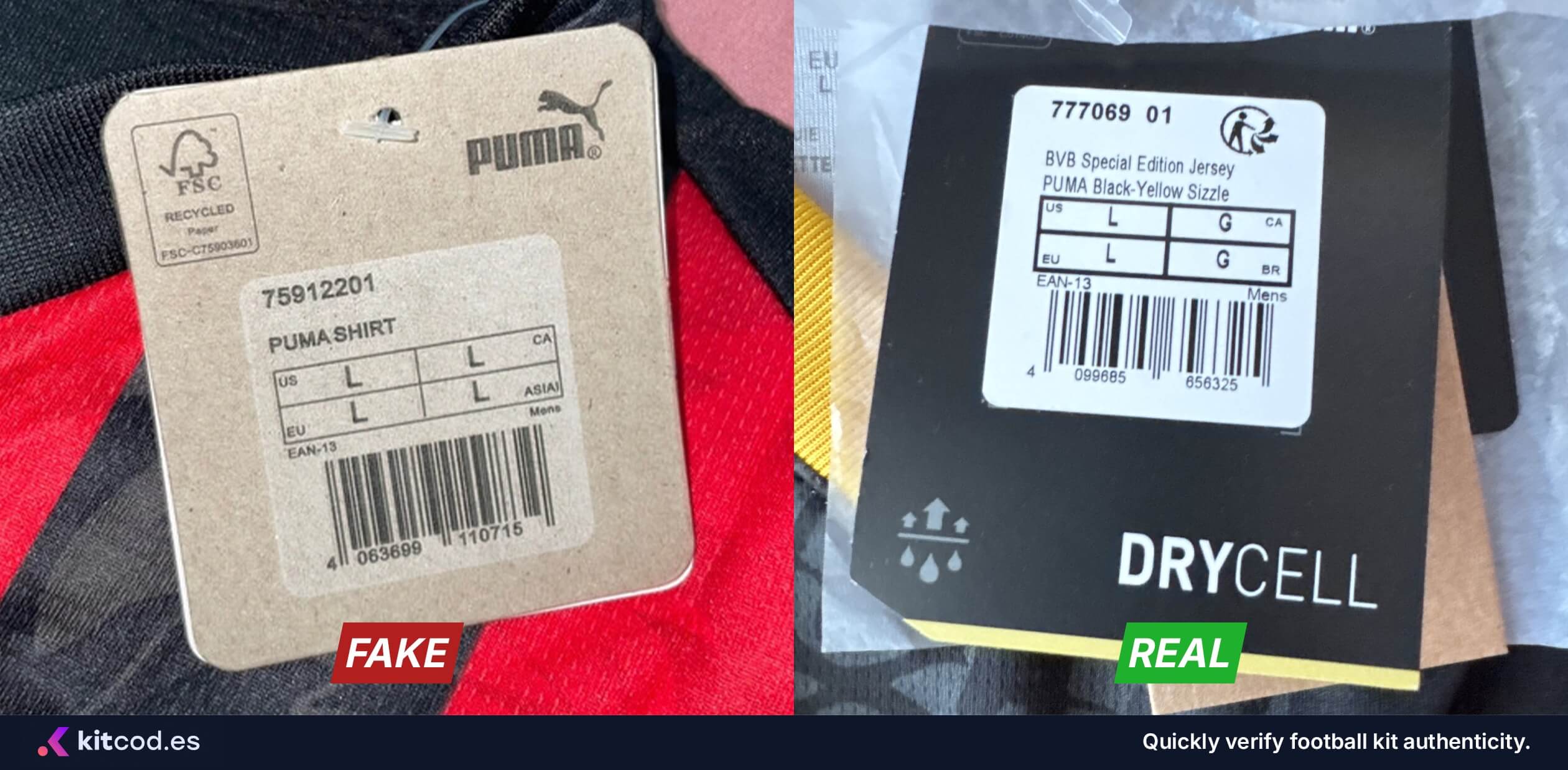
Information
The product code on the swing tag should match the one found on the product code label inside the shirt. Any mismatch between these codes can be a sign of a fake kit. Another strong indicator of a fake is when the label fails to mention the specific kit it's for. Fake labels often use a generic term like "Puma Shirt", which lacks detail. In contrast, genuine labels typically reference the club name and kit type, even if abbreviated, along with the color, which should clearly match the kit.
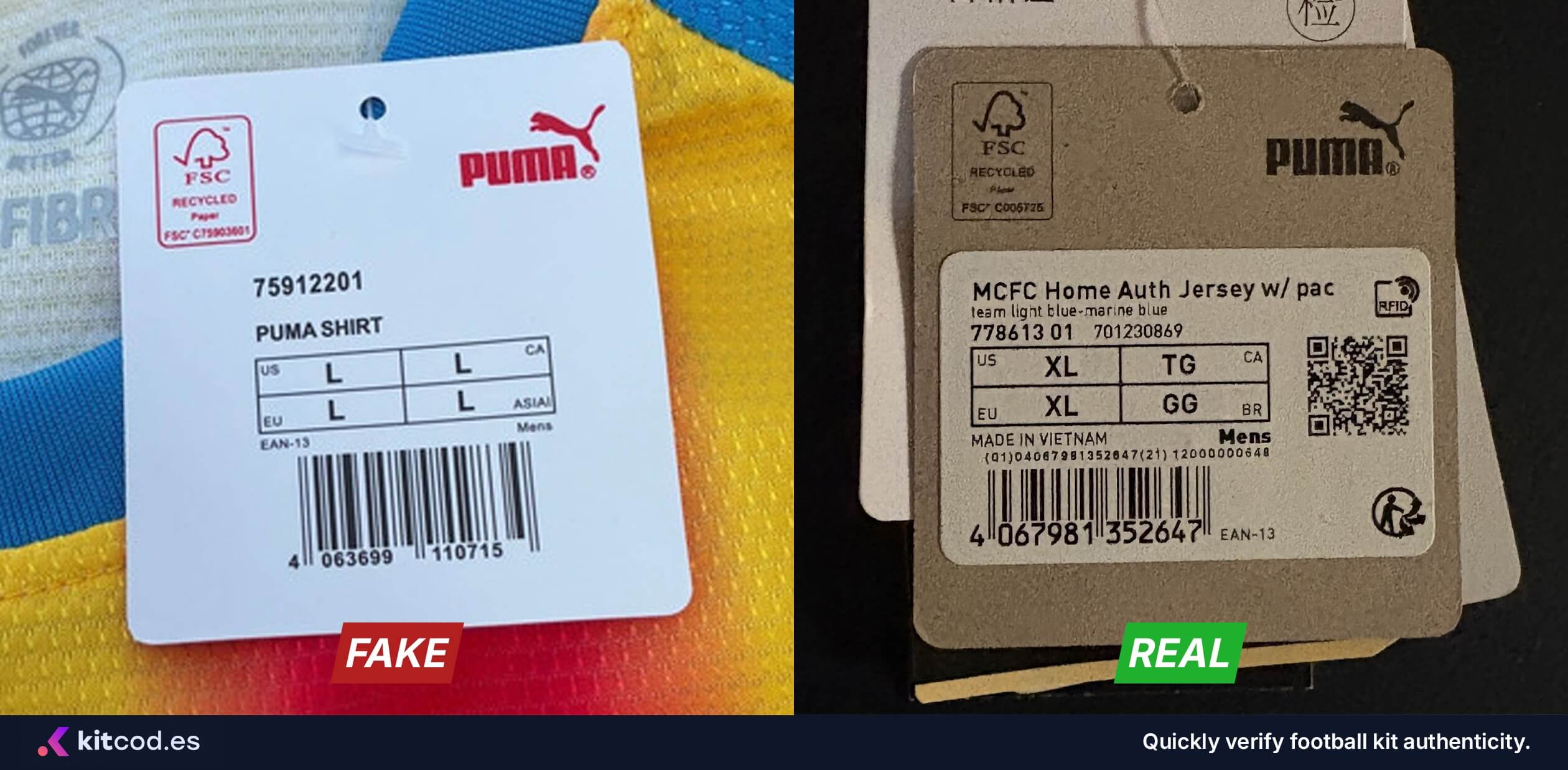
Another giveaway is incorrect or inconsistent sizing information. Different countries often use their own sizing conventions rather than globally standardized labels. For example, Brazil or Canada might use "G" for "Grande" instead of the more common "L" for "Large". Similarly, products intended for the Japanese market may feature extended size codes like "2XO" to indicate larger sizes.
Mismatched or unusual sizing labels that don't align with the region the product is supposedly made for can be a red flag when identifying counterfeits.
The care labels
Puma kits include a care label sewn into the inner side seam, usually near the waist area, underneath the product code label. While its main purpose is to provide washing instructions, it's also a valuable detail for authenticating a shirt.
What to look out for:
- Typos, poor spacing, or grammatical errors can be common on fake kits
- Mismatched manufacturing info - The country listed here should match the one on the neck label.
- Pen marks or scribbles - These may appear on player-spec kits, but can also indicate tampering if found on retail versions.
- Missing country of manufacture - Legally required and must always be present.
Always try to compare the care label's layout, language, and formatting to a known authentic shirt from the same season. This is often where counterfeiters make small but revealing mistakes.
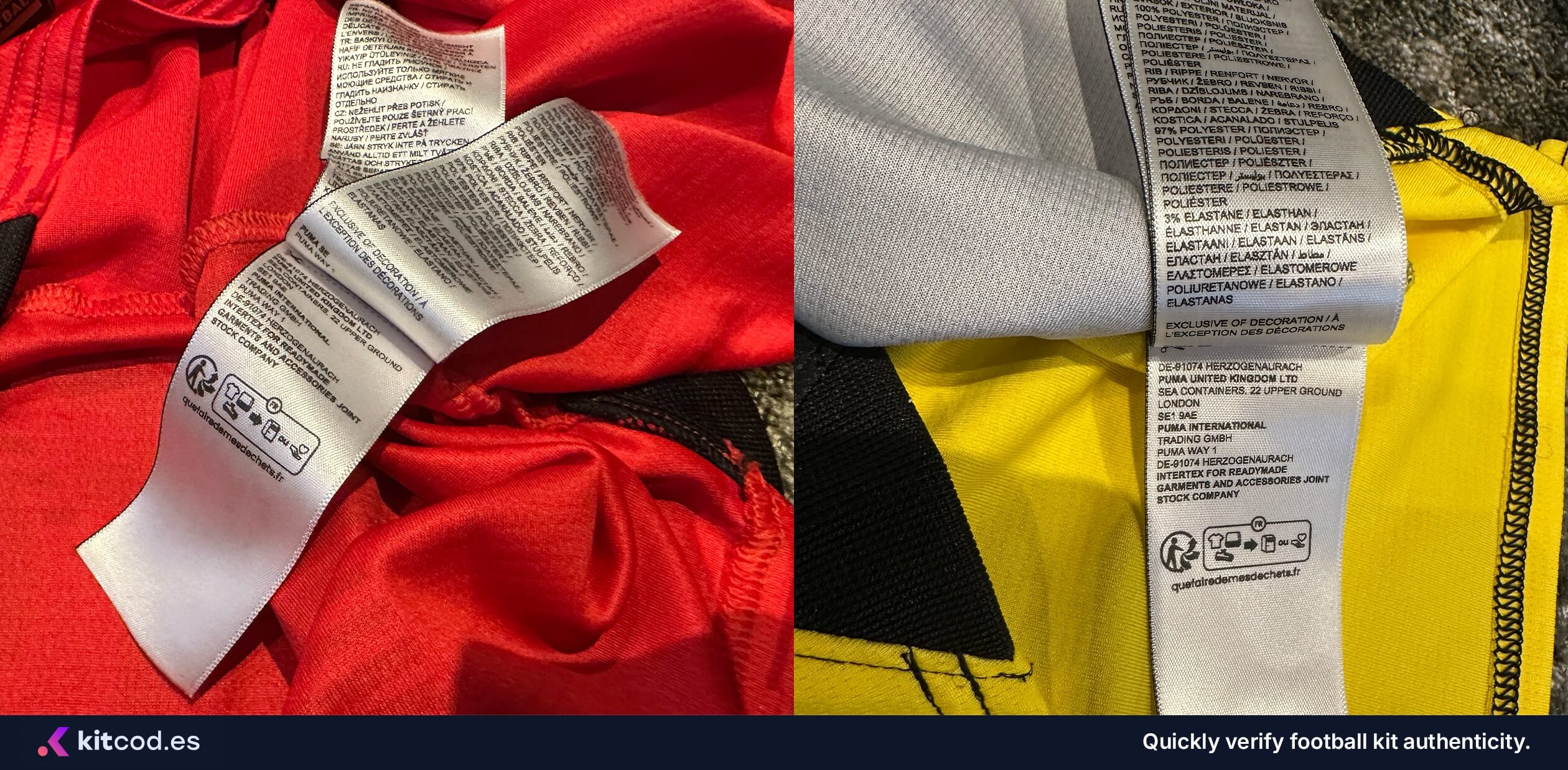
The neck label
The neck label or size print inside the collar is a key detail when verifying the authenticity of a Puma football kit. It typically features details such as the kit size across diferent regions, the kit technology being used, and a manufacturing country.
The reference chart below provides a general overview of the sizing label formats used during different time periods. Please note that this list is not definitive, and variations may occur depending on the product style, region, or manufacturing batch. The timeframes are approximate and may overlap across different eras and designs.
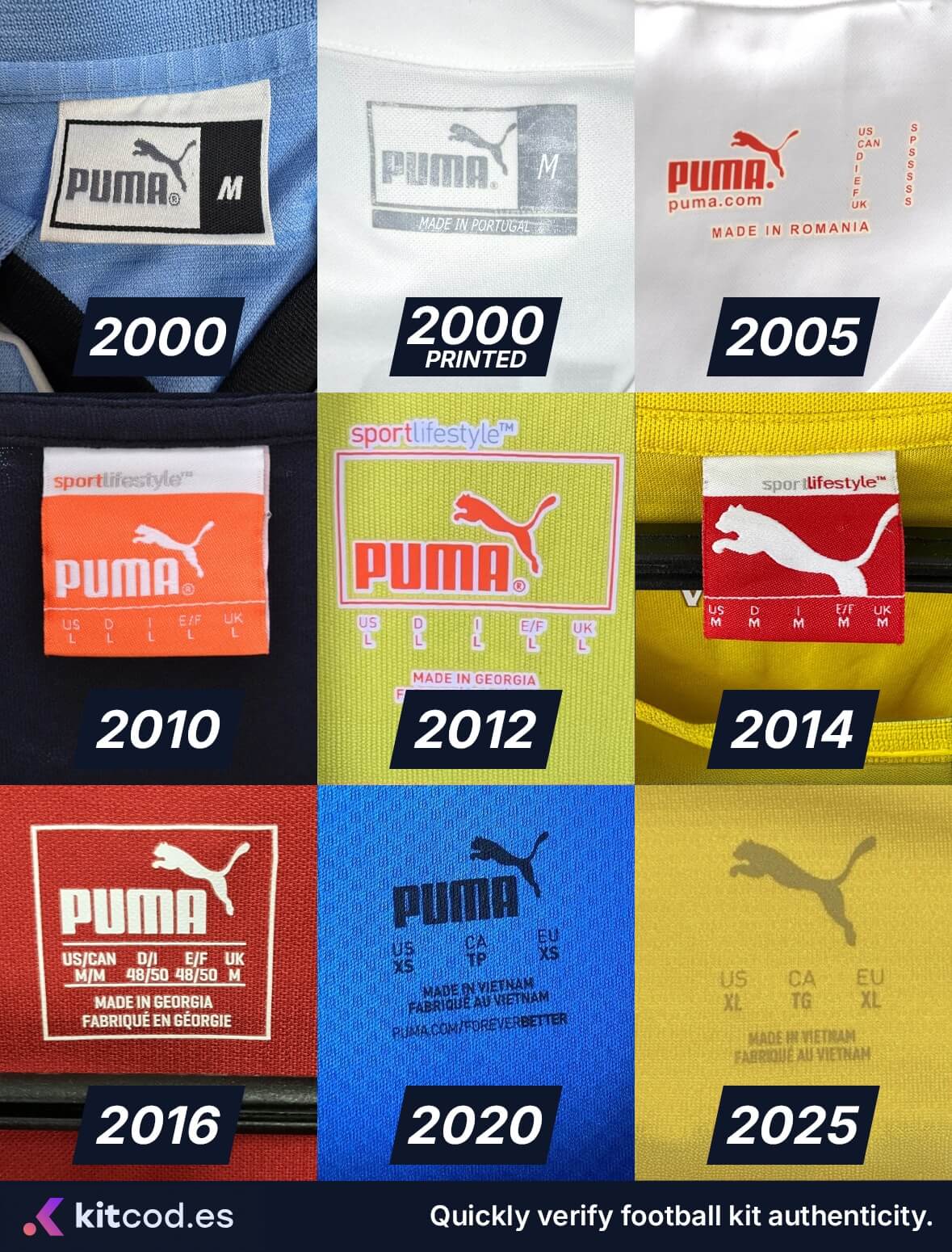
Made in ...
The manufacturing country printed on the neck label should always match the one listed on the tags inside the kit. For example, if the neck label says "Made in Vietnam", the inner tag should say the same. Inconsistencies between these two locations are a common red flag for counterfeit kits. While Puma manufactures kits in several countries (e.g., Vietnam, Thailand, Turkey), the labeling should always be consistent throughout the kit.
Size information
This size conversion chart shows how kit sizes align across different regions. When verifying a kit's authenticity, the size listed in the neck label should match the corresponding value on the wash tags inside the kit. Pay close attention to the Japanese size (J), counterfeit kits often get this wrong, either by mismatching it with the other sizes or using unrealistic codes (e.g., "J: S" for a US L).
| UK | US | F | D | I | E | CDN | J |
|---|---|---|---|---|---|---|---|
| S | S | S | S | S | S | S/P | M |
| M | M | M | M | M | M | M | O |
| L | L | L | L | L | L | L/G | 2XO |
| XL | XL | XL | XL | XL | XL | XL/TG | 3XO |
| XXL | XXL | XXL | XXL | XXL | XXL | XXL/TTG | 4XO |
In more recent Puma releases you might notice a shift in how Japanese sizing is displayed. Traditionally, Puma used the letter "O" (a common sizing convention in Japan) to indicate a large size. However, newer kits increasingly use "L" instead of "O" to align more closely with Western sizing conventions. This change doesn't indicate a fake but is something to be aware of when comparing older and newer kits.
The security tag
On modern Puma shirts, you'll often find a small black authenticity tag located at the bottom left of the shirt when viewed from the front. This tag typically features a unique alphanumeric code. Unlike the internal product labels, searching this tag code alone won’t reliably return results, unless the shirt is a counterfeit.
However, on more recent releases, this label has been replaced by a smaller black tag that simply reads "Authentic Licensed Football", with no visible code.
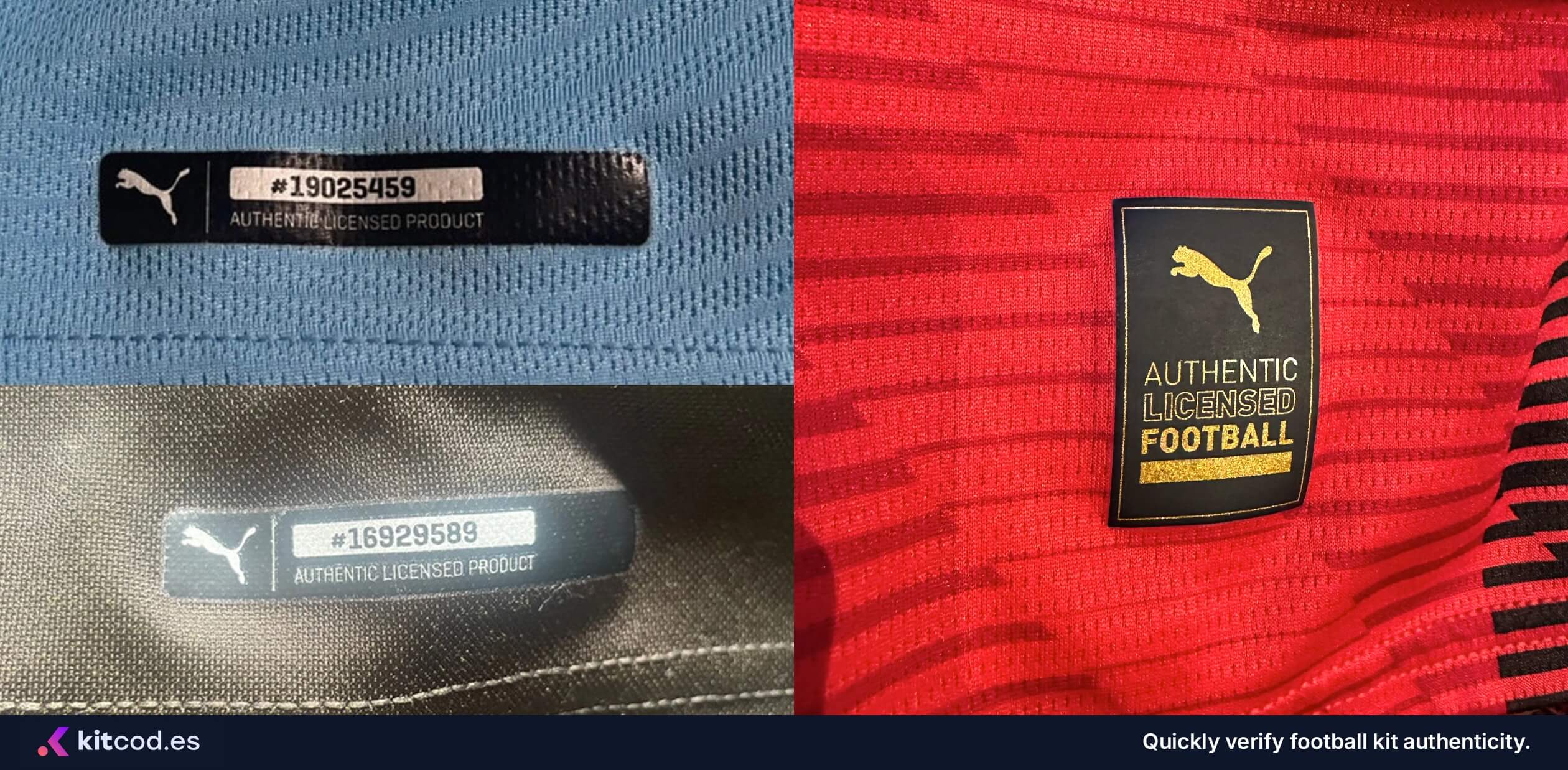
Logos, crests, and stitching
The club crest is one of the most noticeable and telling details on a football kit, and a common giveaway on counterfeit Puma kits. While fake kits often get the general shape right, they frequently miss the finer details that set real Puma embroidery or heat-transfers apart.
The Puma logo
The Puma logo is a reliable marker of authenticity, as counterfeit kits often exhibit noticeable imperfections in the cat's shape, proportions, or stitching. On genuine kits, the logo is typically cleanly embroidered or heat-pressed, with sharp edges and consistent placement. These are hallmarks of Puma's quality standards, especially in their logo.
One common giveaway on counterfeit Puma kits is what's someetimes referred to as the "Fat Cat", a distorted version of the iconic Puma logo where the leaping cat appears noticeably thicker or bulkier than it should. While genuine Puma logos are sleek, agile, and precisely proportioned, fake versions may feature a cat that looks stubby, stretched, or overly muscular, lacking the dynamic form of the original design.
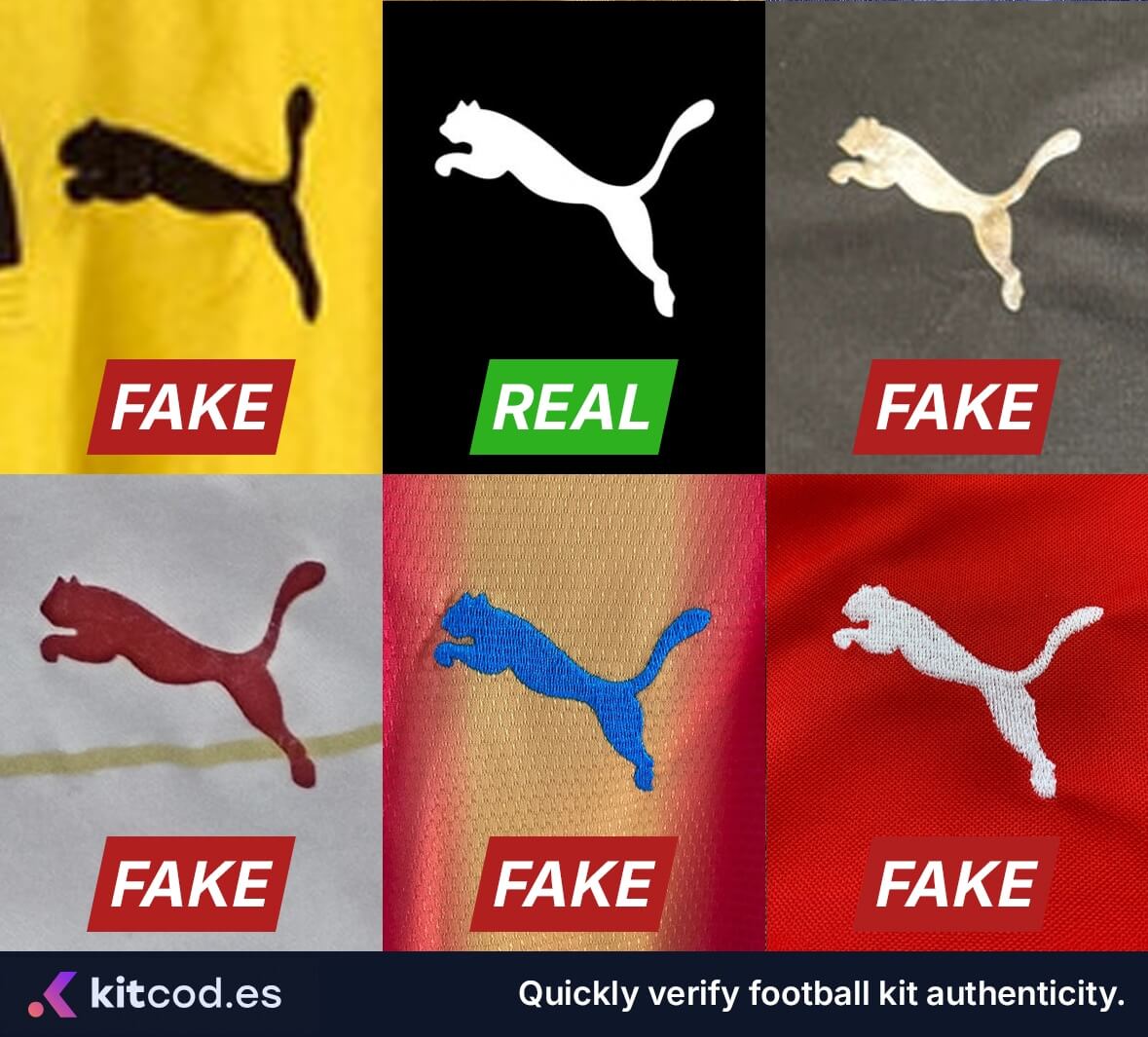
This visual flaw can be subtle at a glance, but becomes obvious when compared side-by-side with an authentic logo. The "Fat Cat" is usually accompanied by inconsistent stitching, off-center placement, or low-quality printing, further signaling a replica. If the Puma looks like it bulked up at the gym, it's probably not the real thing.
Pro tip
Compare the listing with official product photos or verified examples from trusted sources. Even minor differences in spacing, stitch density, or the finish of the crest can be enough to spot a fake.
Club crests
The club crest is one of the most recognizable and intricate elements on a football kit, making it a reliable area for spotting flaws. On authentic kits, the crest is typically precisely stitched or heat-applied, with clean edges, correct proportions, and consistent spacing between elements. In contrast, fake crests may show misaligned text, irregular spacing, blurred outlines, or oversized/undersized icons relative to the original design. Elements like stars, lettering, or borders may appear off-center or unevenly spaced. A poorly executed crest is often one of the clearest indicators that a kit isn't genuine.
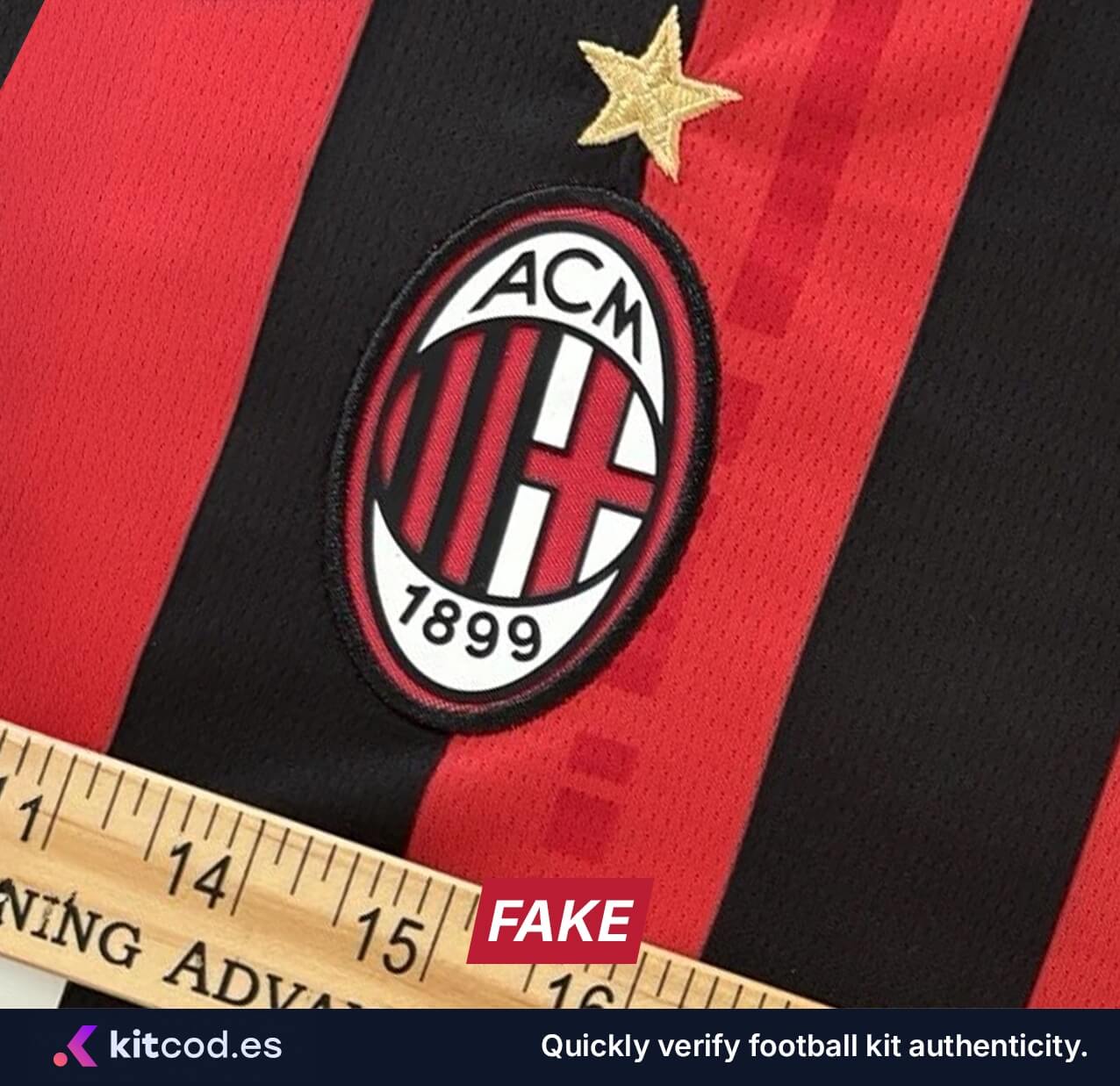
RN62200 and CA06311
The numbers RN62200 and CA06311 are registration numbers that appear on many Puma garments, including football kits. These codes are not unique to individual items or specific products, instead, they are broad identifiers registered with U.S. and Canadian authorities. RN62200 is Puma's U.S. Registered Identification Number (RN), and CA06311 is their Canadian equivalent.
These numbers simply confirm that Puma is the manufacturer, but they are printed on virtually every Puma garment, regardless of style, year, or category. As such, they cannot be used to verify authenticity or date a kit, and they often appear on fake kits as well. While it's good to know what they are, they offer little value when it comes to actual authentication.